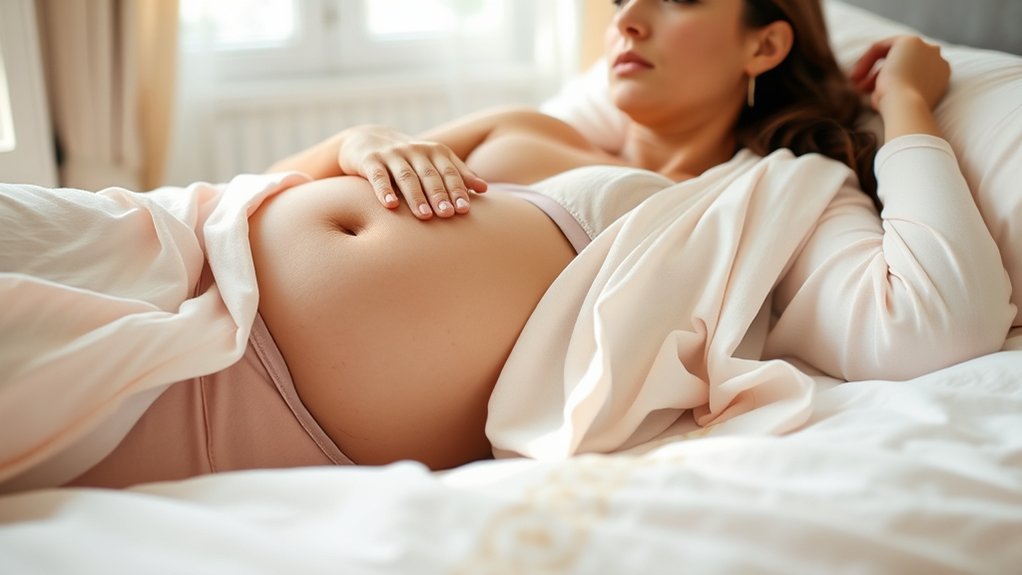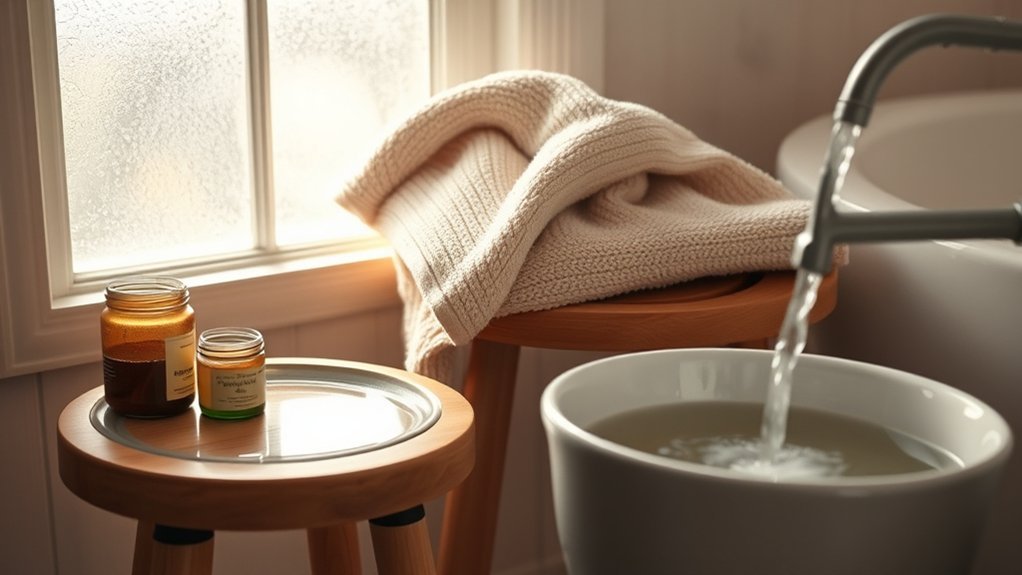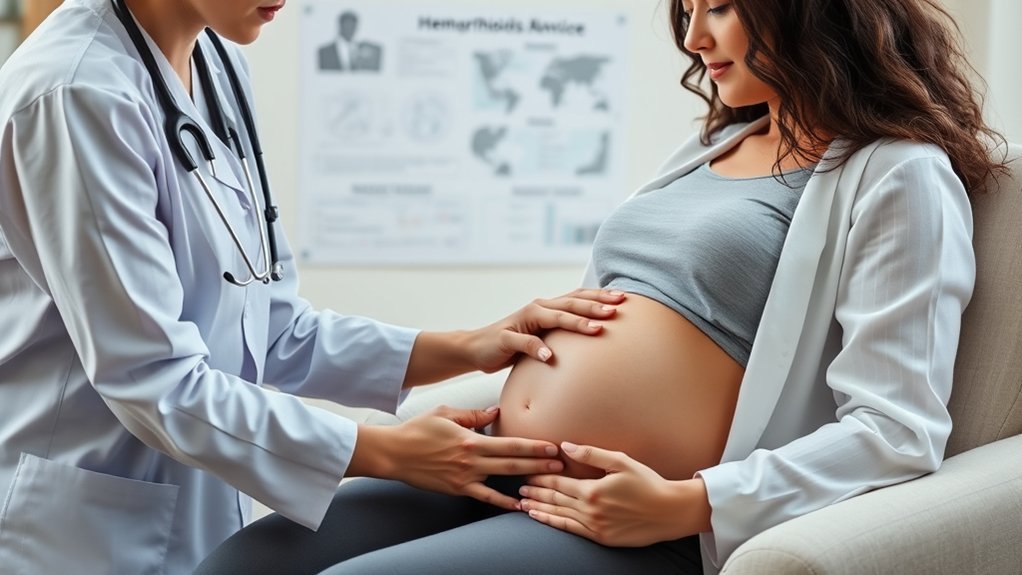If you’ve recently given birth, you might be grappling with the discomfort of postpartum hemorrhoids. It’s important to separate fact from fiction regarding this common issue. Many new mothers are misinformed about the causes and treatment options, which can lead to unnecessary anxiety. Understanding the realities of postpartum hemorrhoids can empower you to manage symptoms effectively. So, what should you really know about these pesky issues and how to tackle them?
Understanding Hemorrhoids

Hemorrhoids, those swollen veins in your rectal area, can be a painful and uncomfortable reality for many postpartum women.
Approximately 25% of you may experience hemorrhoids postpartum, which can either develop anew or continue from pregnancy. There are two main types: internal hemorrhoids, located inside the anal sphincter, and external hemorrhoids, which protrude outside the anus.
The increased pressure from your expanding uterus along with hormonal changes during pregnancy often lead to these issues, especially in the third trimester and during labor.
Fortunately, most postpartum hemorrhoids shrink within days to weeks after delivery, with significant improvement typically observed by two weeks postpartum.
Understanding these facts can help you manage this common condition more effectively.
Causes of Postpartum Hemorrhoids
Postpartum hemorrhoids often stem from the increased pressure on your pelvic veins during pregnancy, affecting about 40% of new mothers.
The pushing phase in labor can also put extra strain on the rectal area, leading to hemorrhoid formation.
Additionally, factors like hormonal changes and the size of your baby can heighten your risk during this time. Furthermore, awareness initiatives to address postpartum mental health are crucial in understanding the broader implications of postpartum recovery.
Pregnancy Pressure Factors
During pregnancy, various factors contribute to the increased risk of developing hemorrhoids after delivery. The expanding uterus exerts pressure on your pelvic veins, which can lead to hemorrhoids in about 40% of postpartum women.
Hormonal changes, particularly the relaxation of blood vessel walls due to progesterone, often cause constipation, making bowel movements more difficult. This straining can increase your risk of hemorrhoids during childbirth.
Larger babies, especially those over 8.4 pounds, and the use of instrumental delivery methods further elevate this risk. Hemorrhoids typically form during the third trimester and can manifest within one to two days postpartum due to the combined effects of pressure and strain.
If you’re pregnant or breastfeeding, being aware of these factors is vital for prevention.
Labor and Delivery Impact
The culmination of pregnancy often leads to considerable physical changes that can directly impact your experience during labor and delivery.
The pressure from your expanding uterus can cause swelling in the veins of the rectal area, increasing the likelihood of developing postpartum hemorrhoids. During childbirth, straining while pushing can further exacerbate this swelling or even create new hemorrhoids.
If you experience an instrumental delivery, like forceps or vacuum extraction, you may face heightened pressure on your pelvic region, increasing your risk. Delivering a larger baby, weighing over 8.4 pounds, also places more strain on pelvic veins.
Hemorrhoids can appear within one to two days after delivery, highlighting how labor and delivery can considerably affect this condition.
Common Myths About Postpartum Hemorrhoids
Here are some truths you should know:
- About 40% of women may experience postpartum hemorrhoids, even if they didn’t have them during pregnancy.
- Most hemorrhoids resolve on their own within six to 12 weeks, so they aren’t necessarily permanent.
- Effective home remedies, like sitz baths and over-the-counter creams, can relieve pain.
- Many new mothers find support through local breastfeeding drop-in centers, which can provide valuable resources for postpartum recovery.
Don’t let embarrassment hold you back. It’s important to consult your doctor about postpartum hemorrhoids, as they’re a common issue.
Symptoms of Hemorrhoids Postpartum
After giving birth, you might notice symptoms like itching, pain, and swelling around your anus, which can make everyday activities uncomfortable.
It’s important to recognize these signs, as up to 40% of new mothers experience hemorrhoids during this time.
Knowing the differences between external and internal hemorrhoids can help you identify your condition and seek appropriate care.
Common Symptoms Experienced
Experiencing symptoms of hemorrhoids postpartum can be quite common, affecting about 40% of women during this period.
These postpartum hemorrhoids often manifest with a range of uncomfortable symptoms, including:
- Rectal bleeding, which may appear as bright red blood on toilet paper or in the stool.
- Painful swelling, leading to irritation around the anus and discomfort during bowel movements.
- General discomfort while sitting, making daily activities challenging.
The veins in the lower rectum may become swollen and irritated, contributing to these symptoms.
While many women notice significant improvement within two weeks, it’s essential to seek medical advice if your symptoms persist or worsen.
Distinguishing Hemorrhoid Types
Understanding the different types of hemorrhoids is essential for postpartum recovery.
Postpartum hemorrhoids can be classified as internal, external, thrombosed, or prolapsed. Internal hemorrhoids are located inside the anal sphincter, while external hemorrhoids protrude outside the anus. Thrombosed hemorrhoids occur when blood clots form in external hemorrhoids, causing significant pain. Prolapsed hemorrhoids are internal hemorrhoids that protrude outside the anal opening during bowel movements.
Common symptoms of hemorrhoids include blood in the stool, pain during bowel movements, and itching around the anus.
It’s important to distinguish these types from more serious conditions, such as anal cancer or rectal prolapse, which may present similar symptoms but require different treatments. Recognizing these differences can aid in effective management.
Effective Treatment Options
When dealing with postpartum hemorrhoids, effective treatment options can greatly ease your discomfort and promote healing. Here are some recommended methods:
- Topical treatments: Over-the-counter creams containing witch hazel or hydrocortisone can help reduce inflammation and itching associated with hemorrhoid symptoms.
- Sitz baths: Soaking the affected area in warm water for 10-15 minutes several times a day provides significant relief and encourages healing.
- Dietary changes: Increase your fiber intake with fruits, vegetables, and whole grains, and stay hydrated to avoid constipation, which can strain pelvic veins and worsen symptoms.
If these treatment options don’t alleviate severe pain or bleeding, it’s crucial to seek medical attention for further intervention.
Home Remedies for Relief

After exploring effective treatment options for postpartum hemorrhoids, it’s helpful to contemplate home remedies that can provide additional relief. Here are some remedies you can try:
| Remedy | Benefits |
|---|---|
| Sitz Baths | Soothes swelling and discomfort |
| Witch Hazel | Alleviates itching and irritation |
| Ice Packs | Reduces swelling and numbs pain |
| Increased Fiber | Prevents constipation, easing bowel movements |
| Over-the-Counter Creams | Offers temporary relief from pain |
Incorporating sitz baths, witch hazel, and ice packs can enhance your comfort. Additionally, increasing your fiber intake helps prevent constipation, a key contributor to postpartum hemorrhoids. It’s essential to maintain good nutrition practices to support overall health during the postpartum period. Don’t forget about over-the-counter creams for quick relief, making daily activities more manageable.
Prevention Strategies for Postpartum Hemorrhoids
To prevent postpartum hemorrhoids, adopting healthy lifestyle habits is key. Here are some effective strategies you can implement:
- Maintain a high-fiber diet with plenty of fruits, vegetables, and whole grains to prevent constipation.
- Drink 8 to 10 cups of water daily to keep your digestive system hydrated and support regular bowel movements.
- Engage in regular physical activity, like brisk walking, to improve circulation and promote bowel health.
Additionally, remember to avoid prolonged sitting or standing to reduce pressure on rectal veins.
Incorporating Kegel exercises can also strengthen pelvic muscles and enhance circulation, lowering your risk of developing postpartum hemorrhoids.
When to Seek Medical Attention
Even with proactive prevention strategies in place, postpartum hemorrhoids can still occur and may sometimes lead to complications.
It’s essential to seek medical attention if you experience severe pain that home remedies don’t alleviate, as this may signal a more serious issue. Heavy rectal bleeding or bright red blood in your stool should prompt an immediate consultation with your doctor to rule out complications.
If your hemorrhoids become hard, painful, or exhibit signs of a blood clot, you’ll need a medical evaluation to explore treatment options.
Additionally, persistent symptoms that don’t improve after self-care measures warrant a visit to your healthcare professional, especially if you’re concerned about the size or appearance of your hemorrhoids.
The Importance of Professional Guidance

While many women may feel hesitant to discuss postpartum issues like hemorrhoids, seeking professional guidance is crucial for effective management and recovery. Consulting your doctor about postpartum concerns helps guarantee accurate diagnosis and treatment, as hemorrhoid pain can be confused with more serious conditions.
Remember:
- If home remedies aren’t working, professional intervention may be necessary.
- Persistent symptoms could indicate the need for follow-up visits to monitor your recovery.
- Healthcare providers can recommend lifestyle modifications and appropriate over-the-counter medications.
Don’t let embarrassment prevent you from addressing these common postpartum issues. By discussing your symptoms openly, you’ll gain valuable insights and tailored advice for managing hemorrhoids effectively, paving the way for a smoother recovery.
Frequently Asked Questions
Are Hemorrhoids More Common After Giving Birth?
Yes, hemorrhoids are more common after giving birth. Approximately 40% of women experience them postpartum due to increased pressure on pelvic blood vessels and factors like constipation and straining during labor.
How Long Will Postpartum Hemorrhoids Last?
Postpartum hemorrhoids typically last six to twelve weeks, with noticeable improvement often within two weeks. Most women find they resolve on their own, but some may need to manage symptoms with self-care strategies.
What Shrinks Hemorrhoids Permanently?
To shrink hemorrhoids permanently, you’ll need lifestyle changes like a high-fiber diet, hydration, and regular exercise. Surgical options may also be necessary if conservative treatments aren’t effective. Maintaining a healthy weight helps too.
How Common Are Hemorrhoids in Moms?
About 40% of moms experience hemorrhoids during the postpartum period. They can develop shortly after delivery due to increased pressure, but most resolve within six to twelve weeks with appropriate care and self-management.
Conclusion
In the end, it’s ironic that something as common as postpartum hemorrhoids can spark so much confusion. You might think childbirth is the only culprit, but pregnancy plays a significant role too. While you may feel tempted to rush to surgery, remember that simple lifestyle changes and home remedies often do the trick. So, hydrate, eat fiber, and don’t hesitate to consult a professional if things get uncomfortable. Empower yourself with knowledge—after all, motherhood comes with enough surprises!
